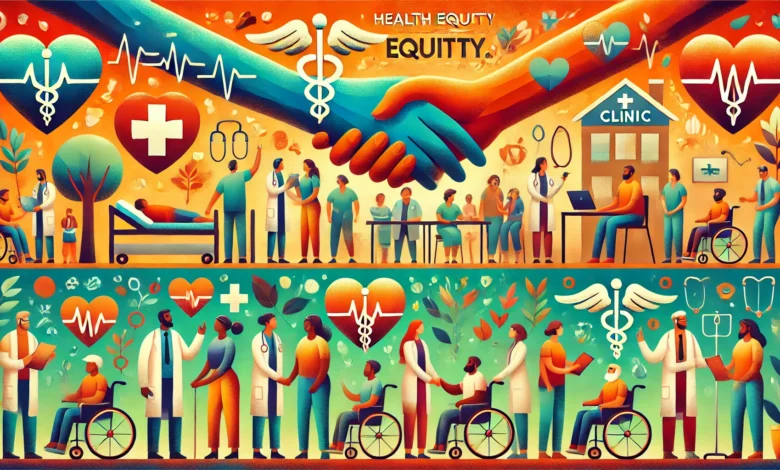Health Equity: Bridging the Gap for a Healthier Future

Understanding Health Equity
Health equity is more than just a buzzword in modern healthcare; it’s a critical goal that underscores the importance of fairness in health outcomes for all individuals. At its core, health equity means that everyone has the opportunity to achieve their highest level of health, regardless of their socioeconomic status, ethnicity, location, or any other defining characteristic. This concept isn’t about giving everyone the same resources but ensuring that everyone has access to what they need to thrive.
To truly grasp health equity, it’s essential to recognize the distinction between equality and equity. Equality means providing the same resources to everyone, while equity tailors resources to meet specific needs. For instance, in a healthcare setting, equity could involve offering additional support to underserved communities that face barriers like poverty or lack of transportation.
Health equity matters because disparities in healthcare don’t just affect individuals; they ripple through families, communities, and entire nations. When certain groups experience poorer health outcomes due to systemic issues, it creates a cycle of inequality that is hard to break. Addressing health equity is not just a moral imperative but also an economic one, as healthier populations contribute more effectively to society.
Factors Contributing to Health Inequities

Health inequities don’t happen in isolation. They result from a combination of social, economic, environmental, and systemic factors that create barriers to good health. Let’s explore some of the key contributors:
1. Socioeconomic Status
Socioeconomic status is one of the most significant predictors of health outcomes. People with lower incomes often have limited access to healthcare services, nutritious food, and safe housing. They are also more likely to work in jobs without health benefits or sick leave, further compounding health challenges.
Additionally, poverty often intersects with other forms of disadvantage, such as limited educational opportunities or exposure to unsafe environments. These overlapping issues create a perfect storm that perpetuates poor health outcomes across generations.
2. Systemic Racism
Systemic racism plays a pervasive role in creating health disparities. Historically marginalized groups often face discrimination within healthcare systems, leading to mistrust and reduced utilization of services. Moreover, these groups frequently reside in areas with fewer healthcare facilities, lower-quality schools, and limited employment opportunities.
Addressing systemic racism requires dismantling structural barriers and ensuring that healthcare systems are inclusive and culturally competent. This isn’t a quick fix but a long-term commitment to fostering equitable treatment for all individuals.
3. Geographic Barriers
Where you live significantly impacts your health. Rural areas often lack adequate healthcare infrastructure, leaving residents with fewer options for medical care. Urban areas, while typically better resourced, can still face inequities, especially in underserved neighborhoods.
Transportation challenges and the digital divide further exacerbate these geographic barriers. For instance, telehealth has been a game-changer for many, but without reliable internet access, rural and low-income populations can’t benefit from these advancements.
Strategies for Achieving Health Equity
Tackling health inequities requires a multifaceted approach that involves individuals, communities, and institutions working together. Here are some strategies to bridge the gap:
1. Expanding Access to Care
Access to healthcare is a fundamental step toward health equity. This involves not only increasing the number of healthcare facilities in underserved areas but also ensuring that these facilities are well-equipped and staffed by culturally competent professionals.
Community health initiatives can play a vital role in this effort. Mobile clinics, for example, can bring essential services to hard-to-reach populations. Additionally, policies that expand health insurance coverage, such as Medicaid expansion, have proven effective in reducing disparities.
2. Addressing Social Determinants of Health
Social determinants of health—such as education, housing, and employment—are critical to achieving equity. Programs that provide affordable housing, improve educational opportunities, and support job training can have a profound impact on health outcomes.
For example, partnerships between healthcare providers and community organizations can help patients address non-medical barriers to health. A clinic might connect a patient to a local food bank or provide resources for affordable childcare, tackling root causes of health disparities.
3. Promoting Health Literacy
Health literacy is another essential component of health equity. When individuals understand how to navigate the healthcare system, interpret medical advice, and make informed decisions about their health, they’re more likely to achieve positive outcomes.
Educational campaigns, multilingual resources, and one-on-one counseling can all enhance health literacy. Empowering people with knowledge gives them the tools to advocate for themselves and their families.
The Role of Policy in Advancing Health Equity
Policy change is a powerful driver of health equity. Governments and institutions must commit to policies that prioritize equitable health outcomes. This includes funding for community health programs, enforcing anti-discrimination laws, and setting measurable goals for reducing disparities.
Public health policies should also focus on preventive care. Investments in vaccinations, screenings, and early intervention programs not only save lives but also reduce healthcare costs in the long run. By prioritizing prevention, we can address issues before they become critical, costly problems.
The Path Forward
Health equity is not an unattainable dream—it’s a goal that requires collective effort and sustained commitment. Individuals can contribute by advocating for fair policies, supporting community health initiatives, and being mindful of biases in their own lives. Healthcare providers can work to create inclusive environments that respect and address the unique needs of each patient.
Ultimately, achieving health equity benefits everyone. When we invest in the health and well-being of the most vulnerable, we create stronger, more resilient communities. It’s not just about fairness; it’s about building a healthier future for all.



